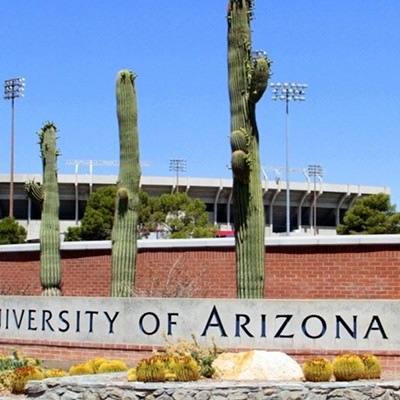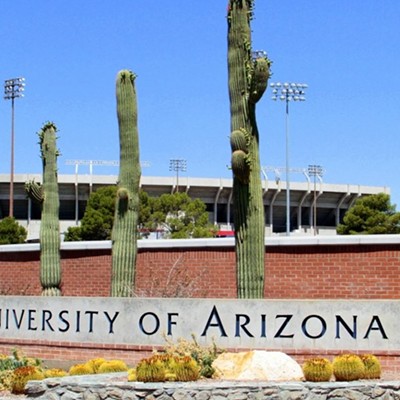UA President Peter Likins has asked all departments to chop 2.06 percent from their budgets to cover half of a $12.4 million shortfall. The other half will be paid for with money gained from enrollment and tuition hikes.
"The fundamental driver in all of this is the absolutely astounding and skyrocketing price of health care," said Richard Roberts, UA budget director. "The Legislature has failed to allocate sufficient funds to cover those costs. That's the bottom line."
Roberts said UA employees, like all employees of the state of Arizona, have a portion of each paycheck set aside to pay for health care coverage and other employee benefits. The university then matches the contributions they make--or at least that's how it's supposed to work.
The cuts are necessary because neither the Legislature, which controls health care funding, nor employees have increased their contributions as costs have risen. The UA cannot change the terms of the health care coverage the Arizona Department of Administration negotiates for it, but is responsible for paying the difference.
"The cost of health care is never going to go down," Roberts said. "We have to deal with this new reality."
Every attempt is being made to mitigate the depth of the cuts, said Greg Fahey, associate vice president for government relations. He said the university will stick to its policy of trying to keep research and degree programs as intact as possible.
"When you get hit with a cut, it's difficult to say it won't be negative anywhere, because there's no magic here," Fahey said. "But we have been largely successful with keeping research intact, certainly at keeping instruction programs intact."
According to Roberts, the cuts will likely stall recovery plans following a "difficult three years" in which there were many layoffs.
"We'd had great hopes we'd be able to replace those positions, and that's frustrating for people," he said. "They want to get under way."
Allison Vaillancourt, assistant vice president of human resources, said layoffs are a possibility again later in the fiscal year. She called the budget woes' effect on morale "huge."
"There's a frustration here, a sense of despair, because it's been going on for so long," Vaillancourt said. "Most departments are feeling like there's only muscle left to cut, so it's a hardship."
Joaquin Ruiz, college of science dean, said he's going to trim administrative costs as much as possible in order to fill an $850,000 hole. But he conceded that any remaining cuts he passes on to the college's 13 departments are going to hurt.
"We're really very sort of tight in our operations," Ruiz said. "For the job that we need to do and to maintain the quality and stature that we're accustomed to, we're as small as we can be."
According to Ruiz, 95 percent of the college's budget is already going to salaries. He called it an "unhealthy" state of affairs that leaves little money to support programs and cover operating expenses.
Maurice Sevigny, college of fine arts dean, claimed that the $220,000 he's being asked to shave will likely translate into a loss of about six full-time positions.
He said previous cuts have forced the college to trim an assistant dean and several secretaries from the payrolls and slash travel expenses for faculty and students. Many majors now have strict admissions standards to limit the number of students who can enroll.
"Once again, it's very difficult digging deeper to cut more from an already underfunded program," he said. "Certainly after enduring a $1.3 million cut, we're pretty bare bones.
"It certainly has curtailed our ability to market ourselves globally and nationally," he added.
Faculty members in the college of medicine were caught off guard by the recent reductions, according to its dean, Keith Joiner. Five general science departments in the college will be especially hard-hit because they don't get as much money from non-state sources as the clinical departments do.
In all, the Health Sciences Center, of which the college of medicine is a part, will trim $871,400, he said.
"It's really having a negative impact, because it's not just the fact there are cuts that might be impacting peoples' lives and programs, but because of the timing--people thought the economy was turning around," Joiner said. "On the one hand, people understand it. On the other, it's just a reflection of how rising health care costs are affecting us all."
Richard Roberts agreed that the disparity between perceptions about the economy and the reality of rising health care costs has some people miffed.
"The economy is generally recovering--that's good--and most people have a perception that it's recovering--that's good," he said. "So people are having a hard time justifying these cuts in their minds. When all is said and done, we have to manage this institution within its budget."
According to physics graduate student Joe Marotta, there's been "buzzing" around the UA campus regarding the cuts. Many of his graduate student friends are concerned about there not being enough money to pay them for their teaching assistant positions.
"One guy's really worried," he said. "He keeps asking me what I should do about it, and I don't know what to tell him."
The main concern for Marotta, however, has been getting the courses he needs.
"Without the necessary funding, people may not teach the classes I need to take," the 24-year-old said. "I'd like to be able to take the classes I want to take when I want to take them."












